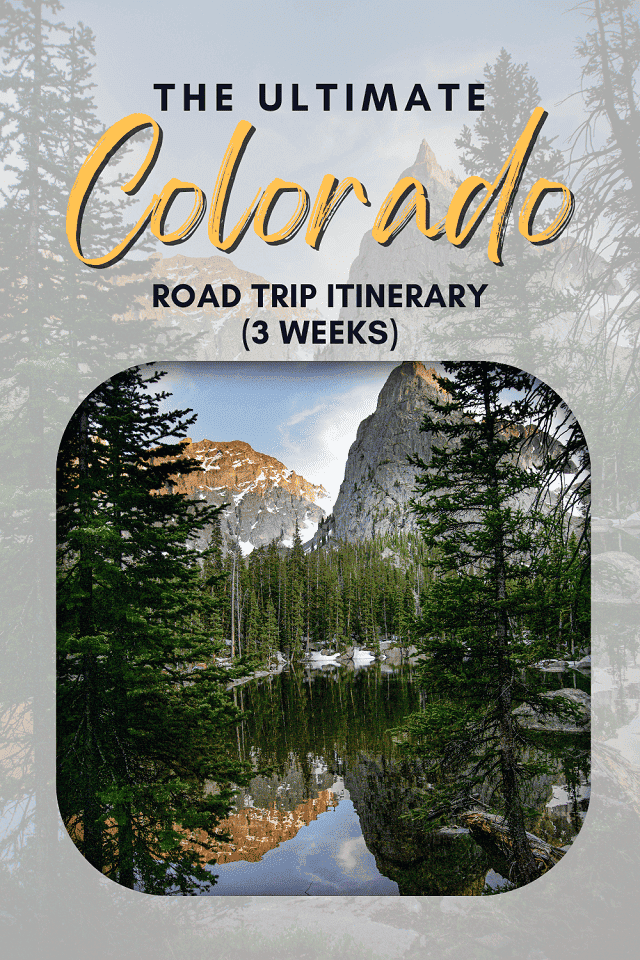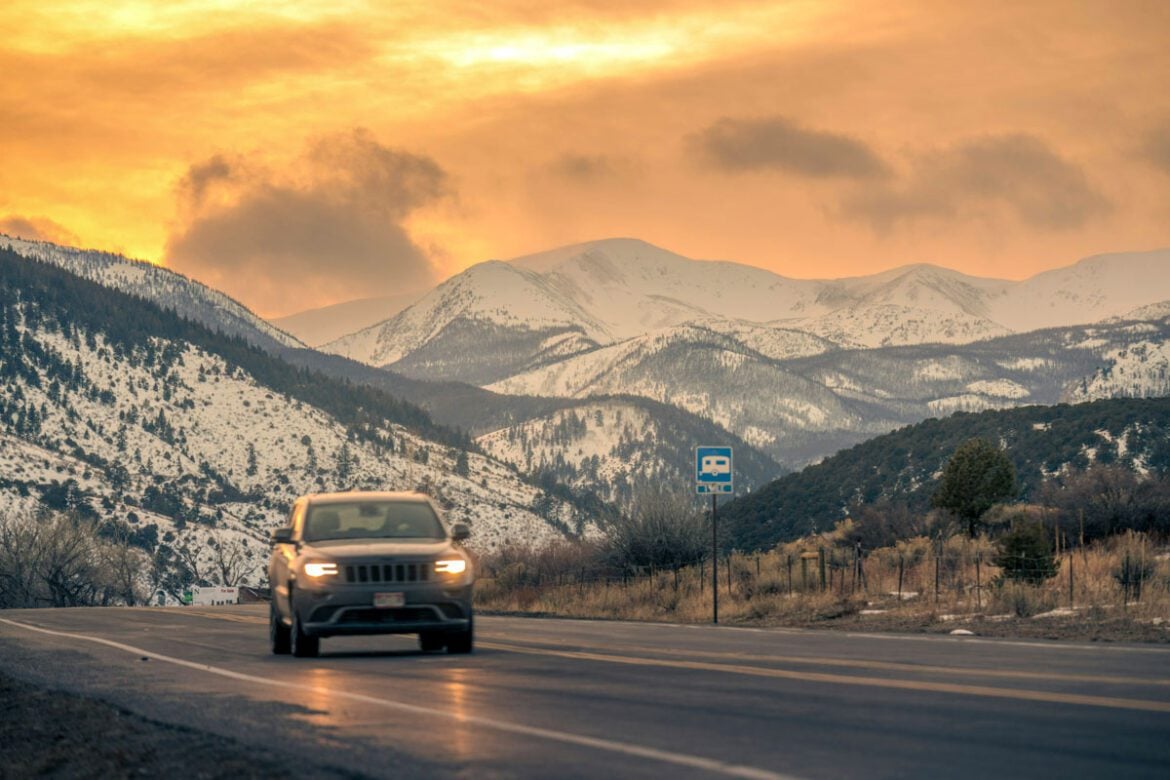Ready for the adventure of a lifetime? My ultimate 3-week Colorado road trip guide has everything you need to experience the best of the Centennial State. With countless visits to Colorado under my belt, I’ve crafted the perfect route to uncover both its iconic landscapes and lesser-known gems.
This itinerary is packed with over 40 bucket list-worthy stops, covering around 1,400 miles of diverse terrain. This includes everything from jaw-dropping mountain vistas and historic mining towns to vibrant cityscapes and hidden hot springs. Along the way, you’ll experience the Rockies in all their glory, explore unique small towns brimming with charm, and soak in views you’ll remember for a lifetime.
In this guide, you’ll find insider tips on must-see attractions, scenic viewpoints, and local secrets to make your trip both epic and stress-free. So, let’s hit the road and dive into the ultimate Colorado adventure!
Table of Contents
Colorado Road Trip (21 Days): At a Glance
Trip Length: 21 days
Start/End: Denver (loop route)
Perfect For: Mountain lovers, hot springs seekers, national park fans, and road trip junkies
Best Time to Go: Mid-June to early October
Total Distance: ~1,400 miles
Route Snapshot (By Region)
Day 1: Denver
Urban energy, historic Union Station, Red Rocks, local eats, and art museums
Days 2–3: Boulder
Flatiron hikes, Pearl Street shopping, farmers markets, tea factory tour
Days 4–6: Rocky Mountain National Park
Trail Ridge Road, Bear Lake, elk sightings, alpine hikes, Estes Park base
Days 7–9: Colorado Springs
Garden of the Gods, Pikes Peak, Manitou Springs, Seven Falls, quirky local shops
Days 10–11: Great Sand Dunes National Park
Dune hikes, sandboarding, Medano Creek splash time, Zapata Falls
Days 12–13: Durango
Historic steam train to Silverton, Animas River Trail, rafting, hot springs
Days 14–15: Mesa Verde National Park
Ancient cliff dwellings, guided tours, Petroglyph Trail, archaeology museum
Days 16–17: Telluride
Free gondola, Bridal Veil Falls, Bear Creek Trail, Old West charm
✈️ My #1 Hack for Cheap 2026 Flights:
It’s January, so flight prices are climbing fast—but you don't have to pay them. I’m currently seeing roundtrips to Europe for under $300 (deals you won’t find on Google Flights).
Step 1: Join Going.com's Free Plan here. It takes 10 seconds and requires no credit card.
Step 2: If you're doing a big trip this year, grab the 14-day free trial of Premium. You can even use my code JON25 for 25% off.
Seriously, this is the single best money-saving tool I’ve used in 8+ years.
👉 Send me cheap 2026 flightsDays 18–19: Aspen
Maroon Bells, John Denver Sanctuary, mountain hikes, upscale dining
Days 20–21: Glenwood Springs
Hot springs, Hanging Lake, Glenwood Caverns Adventure Park, riverside strolls
Planning the Perfect Colorado Road Trip
A Colorado road trip can be as short or as long as you want, but to really soak in all the best sights, you’ll want to aim for a solid 21 days. Colorado has a ton to offer, and I want you to experience it all without feeling rushed. But hey, if you don’t have 21 days, no worries. This guide is flexible! You can pick and choose your favorite spots and make a shorter trip that fits your schedule.
We’re kicking things off in Denver because it’s the perfect starting point. Whether you’re flying in or live nearby, Denver is right in the heart of the state, making it super easy to hop on the road and start your adventure. Plus, it’s a great city to explore before you hit the mountains.
Here’s the lowdown on everything you’ll need for your Colorado road trip. I’ve got a 21-day itinerary, a map with all the must-see spots, and plenty of tips to make your adventure as smooth and fun as possible.
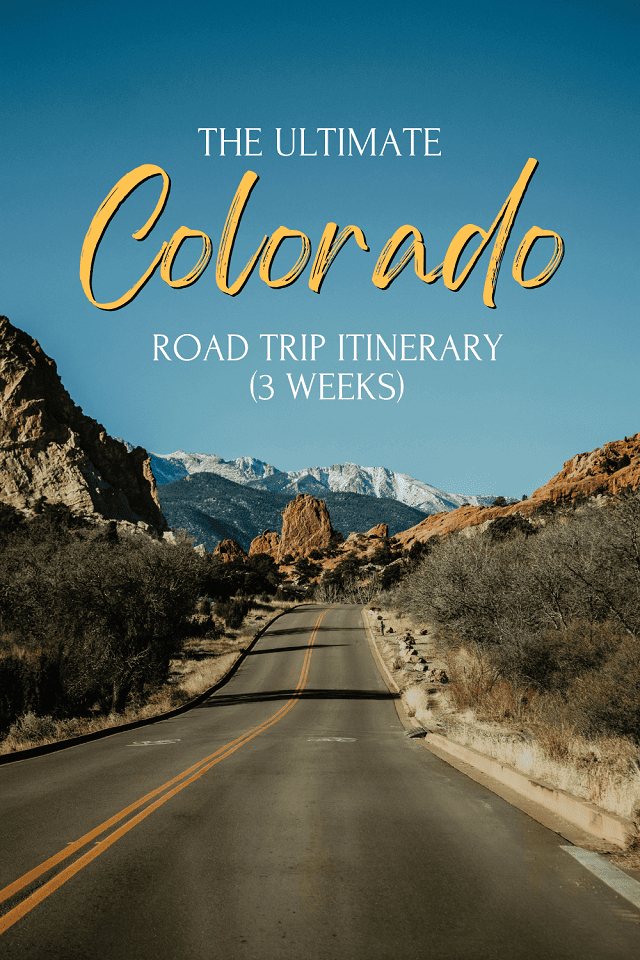
Road Trip Itinerary Map for Colorado
The itinerary map gives you a clear view of all the key stops along your Colorado journey. I’ll break down each destination for you below and share some handy advice to help you keep the trip efficient and stress-free.
Days 1: Denver
Welcome to Denver! If you’re flying in, you’ll land at Denver International Airport (DEN). It’s a good idea to pick up your rental car at the airport so you’re all set to start your road trip. From the airport, head to your hotel in downtown Denver (recommendations below).
Denver’s a vibrant city where you can enjoy top-notch museums, lively breweries, and stunning mountain views all in one place.
Here’s how to best spend your day in Denver:
- Union Station: Start your day at Union Station, Denver’s historic transportation hub. It’s not just a train station; it’s a cool spot filled with cafes, bars, and shops. Grab a coffee at Pigtrain Coffee Co. and people-watch in the beautiful Great Hall.
- 16th Street Mall: Afterward, take a stroll along the 16th Street Mall, a mile-long pedestrian promenade lined with shops, restaurants, and street performers. Pro tip: Use the free MallRide shuttle if your feet need a break.
- Larimer Square: Head to Denver’s oldest and most charming block, Larimer Square. The historic buildings are lit up with strings of lights at night, making it a magical place to grab dinner or a drink. Don’t miss the cocktails at The Green Russell, a speakeasy-style bar tucked away beneath the street—one of the many fun Denver restaurants in the area.
- Denver Art Museum: If you’re into art, make a stop at the Denver Art Museum, a gem in Denver and home to a huge collection of Native American art and contemporary pieces. The architecture of the building itself is a sight to see!
- City Park & Denver Zoo: Here, you can visit the Denver Zoo, which is perfect if you’re traveling with kids (or if you just love animals). The park also offers stunning views of downtown Denver against the backdrop of the Rockies.
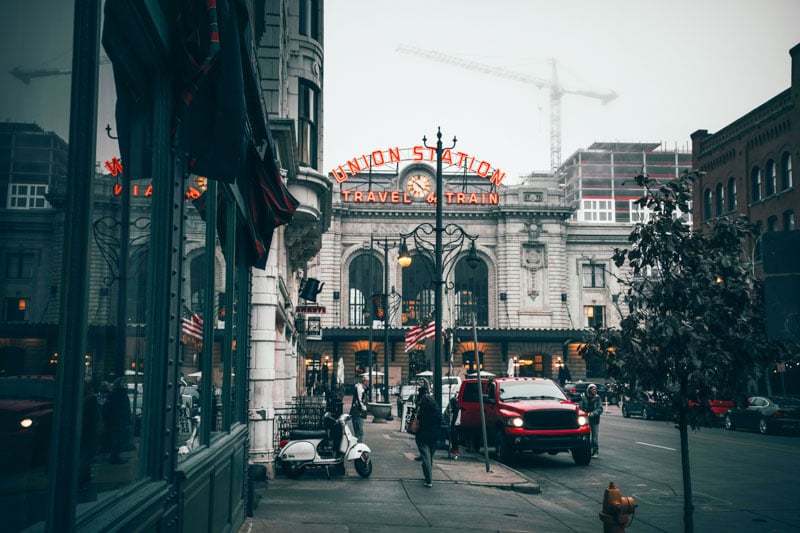
More Denver Attractions
- Denver Museum of Nature & Science: Right next to City Park, this museum is a fun and educational stop with exhibits ranging from dinosaurs to space exploration. Check out the planetarium or catch a film on the giant IMAX screen.
- Botanic Gardens: Spend your afternoon at the Denver Botanic Gardens, a lush oasis in the middle of the city. It’s especially beautiful in the summer when the flowers are in full bloom, but even in winter, the tropical conservatory is a warm escape.
- Red Rocks Park & Amphitheatre: No trip to Denver is complete without visiting Red Rocks. This natural amphitheater is world-famous for its incredible acoustics and stunning setting. Even if there’s no concert, you can hike the trails around the park or just marvel at the views. If you’re there in the morning, join a yoga session on the stage—it’s an unforgettable experience.
- Golden, Colorado: Just a short drive from Red Rocks, head to the charming town of Golden. It’s a great spot for a leisurely lunch and a tour of the Coors Brewery. Afterward, walk along Clear Creek, where you can see kayakers and tubers enjoying the water.
- Mount Evans Scenic Byway (Seasonal): If you’re visiting in the warmer months (late May to September), take a drive up the Mount Evans Scenic Byway, the highest paved road in North America. The views are breathtaking, and you can often spot mountain goats and other wildlife along the way. Be sure to check road conditions before you go—it’s only open seasonally.
Where to Stay: If you’re looking for an epic Colorado stay, some great options include The Crawford Hotel (inside Union Station), The Maven (in the Dairy Block), or Kimpton Hotel Born. All are centrally located and put you right in the middle of the action.
Days 2-3: Boulder
Boulder is the kind of place that feels like a breath of fresh air—literally and figuratively. From Denver, it’s an easy hour’s drive via US-36 West. Nestled right at the base of the Flatirons, this town is known for its laid-back vibe, outdoor adventures, and a thriving local food scene. It’s a quick hour’s drive from Denver, making it the perfect next stop on our Colorado road trip.
Here are some of my most favorite places to visit:
- Pearl Street Mall: The heart of Boulder, Pearl Street is a pedestrian-only street lined with shops, cafes, and street performers. It’s a great spot to grab a coffee, people-watch, and browse local boutiques. Don’t miss Bookworm, a charming local bookstore, or Piece, Love & Chocolate for a sweet treat.
- Chautauqua Park: One of Boulder’s most iconic spots, Chautauqua offers stunning views of the Flatirons and plenty of hiking trails. The Royal Arch Trail is a popular choice—it’s a moderate 3.5-mile round trip that rewards you with incredible views of the rock formations. If you’re visiting in winter, pack microspikes for icy trails.
- Boulder Farmers Market: If you’re here on a Saturday (or Wednesday in summer), swing by the Boulder Farmers Market. It’s one of the best in the state, with fresh produce, local meats, artisanal goods, and food trucks.
- Celestial Seasonings Tea Factory Tour: Take a tour of the Celestial Seasonings factory to see how your favorite teas are made. The best part? The free tea samples and a visit to the famous Peppermint Room, which will clear your sinuses in seconds! Tours are year-round, but it’s especially cozy to visit during the cooler months.
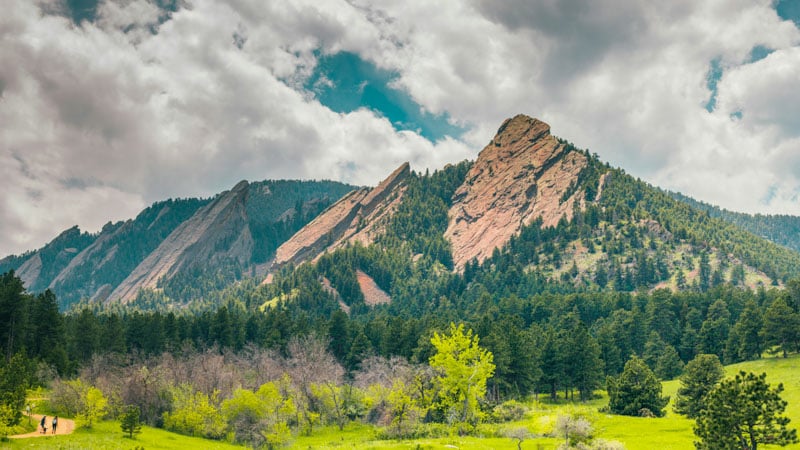
More Places to Visit
- Flagstaff Mountain: Just a short drive from downtown, Flagstaff Mountain offers fantastic views over Boulder and the surrounding area. There are several picnic spots and easy hiking trails like the Range View Trail. In winter, it’s a great place for some peaceful snowshoeing.
- Boulder Creek Path: This 5.5-mile path runs alongside Boulder Creek, providing a scenic route for walking, biking, or even tubing in the summer. It’s a lovely, relaxing way to enjoy Boulder’s natural beauty.
- University of Colorado Boulder Campus: Take a stroll around the CU Boulder campus—it’s beautiful, with its sandstone buildings and views of the Flatirons. The CU Heritage Center in Old Main offers a look into the history of the university and the area.
- Fiske Planetarium: For something a bit different, check out a show at Fiske Planetarium on the CU Boulder campus. It’s one of the largest planetariums between Chicago and Los Angeles, offering everything from star shows to laser light shows set to music.
Suggested Accommodation: If you’re looking to splurge a bit, St. Julien Hotel & Spa offers incredible views of the Flatirons and is just a short walk from Pearl Street. This luxury hotel also has a great spa if you’re in the mood for some relaxation after your adventures.
For something more budget-friendly but still super cool, Basecamp Boulder is a boutique hotel with a quirky, outdoor-themed design. It sits close to Pearl Street!
Days 4-6: Rocky Mountain National Park
Rocky Mountain National Park (RMNP) is a true gem of Colorado, and it’s just an easy hour’s drive from Boulder. The park is famous for its towering peaks, alpine lakes, and an incredible variety of wildlife.
One of the coolest things about this park is the diversity of landscapes! You’ll find everything from dense forests to wide-open tundra, depending on where you are in the park. Plus, there’s a good chance you’ll spot elk, bighorn sheep, or even a moose if you’re lucky. The park’s main gateway is Estes Park, a charming little town that serves as the perfect base for your Rocky Mountain adventures.
Keep your eyes peeled for these attractions:
- Trail Ridge Road: This is the highest continuous paved road in North America, reaching over 12,000 feet in elevation. The drive offers some of the most stunning views in the park, with plenty of pull-offs where you can stop and take photos. Be aware that Trail Ridge Road is usually closed from October to late May due to snow.
- Bear Lake: One of the most accessible and popular spots in the park, Bear Lake offers a picturesque loop trail that’s just under a mile long. It’s an easy, flat hike with beautiful views of the surrounding mountains, making it one of the most beautiful lakes in Colorado.
- Alberta Falls: A short and sweet hike from the Bear Lake Trailhead, Alberta Falls is one of the park’s most popular waterfalls. The hike is just over a mile round trip, making it a great choice if you’re looking for something easy but still rewarding.
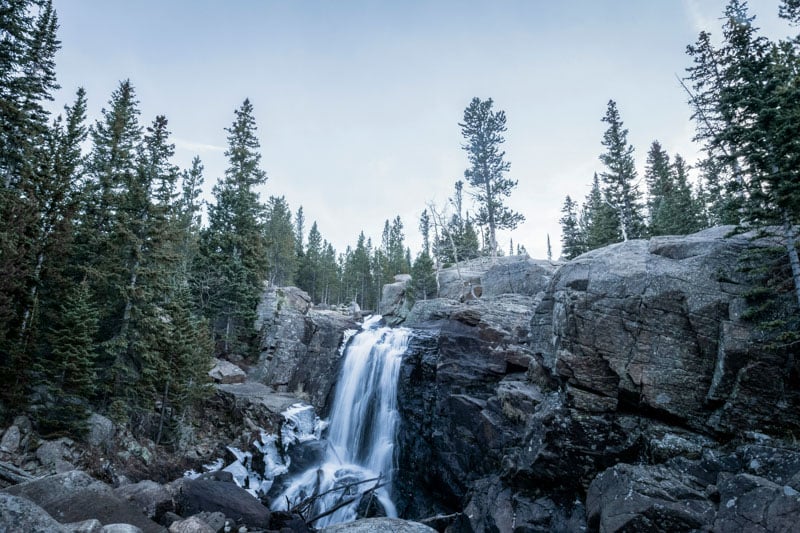
More Attractions in RMNP
- Emerald Lake Trail: If you’re up for a bit more of a hike, head out on the Emerald Lake Trail. This 3.5-mile round trip hike takes you past Nymph Lake and Dream Lake before arriving at the stunning Emerald Lake, all surrounded by dramatic mountain peaks. I
- Wild Basin Area: For those looking to escape the crowds, the Wild Basin area on the southeastern side of the park offers some less-traveled trails and beautiful scenery. The hike to Ouzel Falls is about 5.4 miles round trip. It takes you through forested paths, with several smaller waterfalls along the way.
- Holzwarth Historic Site: If you’re interested in a bit of history, check out the Holzwarth Historic Site. It’s a preserved homestead that offers a glimpse into early life in the Rockies.
- Longs Peak: For the adventurous, Longs Peak is the highest summit in the park, standing at 14,259 feet. The hike to the summit is a strenuous 14.5-mile round trip with over 5,000 feet of elevation gain. It’s not for the faint of heart, but if you’re an experienced hiker, it’s a bucket-list climb. Start early (like 3 AM early) to avoid afternoon thunderstorms, which are common in the summer.
If you’re visiting in the fall, RMNP is famous for its elk rut. This takes place from late September to early October. During this time, you can hear the eerie bugling of bull elk as they compete for mates. Moraine Park is a great spot to witness this natural spectacle!
Days 7-9: Colorado Springs
The drive from Rocky Mountain National Park down to Colorado Springs is a pretty one, and it’s only about two hours, so you’ll have plenty of time to explore once you arrive. The region is one of those places where the landscape does all the talking.
You’ve got towering red rock formations, sprawling mountain views, and some seriously cool attractions that make it worth the visit. The city sits at the foot of Pikes Peak, the famous “America’s Mountain” and one of the top mountains in the US for hiking and skiing.
Here are the top spots to visit in Colorado Springs:
- Garden of the Gods: This public park is filled with towering red rock formations that look like something out of a movie. The park is free to enter and has a variety of easy trails that wind through the rocks. If you’re into photography, sunrise or sunset is the best time to catch those fiery colors. You can also drive through the park if you’re short on time, but I’d recommend getting out and walking around. It’s way more impressive up close!
- Pikes Peak: You can’t come to Colorado Springs and not visit Pikes Peak. You’ve got a couple of options to reach the summit: you can drive the 19-mile Pikes Peak Highway or take the Pikes Peak Cog Railway. Alternatively, if you’re feeling really adventurous, hike the Barr Trail.
- Manitou Springs: This quirky little town is known for its natural mineral springs and funky vibe. Take a walk down the main street and check out the local shops. Also, don’t miss the chance to taste the mineral water from the public fountains. Each spring has a slightly different taste, which is pretty cool. Manitou Springs is also home to the Manitou Incline, a challenging hike that’s basically a giant staircase with 2,744 steps.
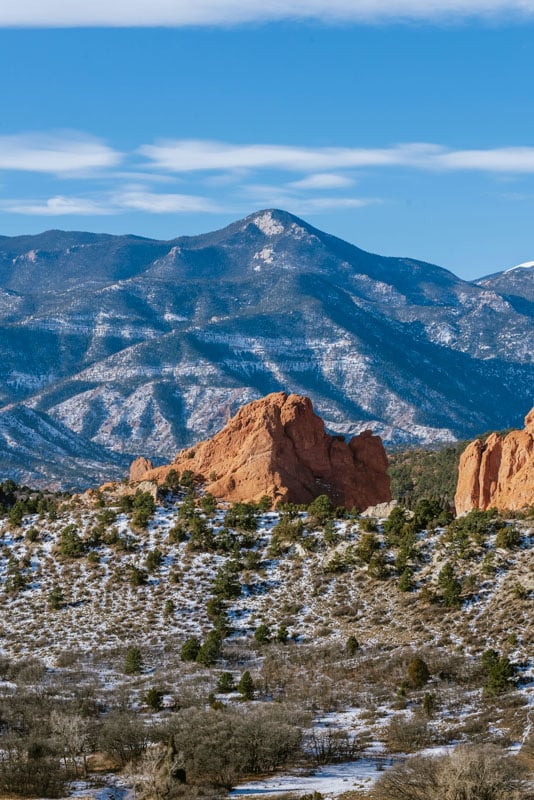
More Attractions You Shouldn’t Miss
- The Broadmoor Seven Falls: Known as “The Grandest Mile of Scenery in Colorado,” Seven Falls is a series of waterfalls cascading down a 1,250-foot canyon. You can hike up the stairs next to the falls or take an elevator to an overlook for a great view. At night, the falls are lit up, creating a pretty spectacular scene and making it one of the best things to do in Colorado Springs at night. There’s also a great little hiking trail at the top called the Midnight Falls and Inspiration Point Trail that offers stunning views of Colorado Springs.
- U.S. Air Force Academy: This is a working military academy, but it’s open to visitors and offers a fascinating glimpse into life at the academy. The Cadet Chapel is the star of the show here with its stunning, modern design. It’s an easy stop on your way to or from Pikes Peak.
- Old Colorado City: This historic district is actually the original capital of the Colorado Territory. Today, it’s a charming neighborhood with art galleries, shops, and restaurants. Check out Simpson’s Rest, a cemetery with graves dating back to the 1800s, for a unique slice of local history.
- Cheyenne Mountain Zoo: If you’re traveling with kids (or you’re just an animal lover), the Cheyenne Mountain Zoo is a fun stop. It’s the highest zoo in the U.S., sitting at over 6,700 feet, and offers some pretty unique animal encounters. You can hand-feed the giraffes here!
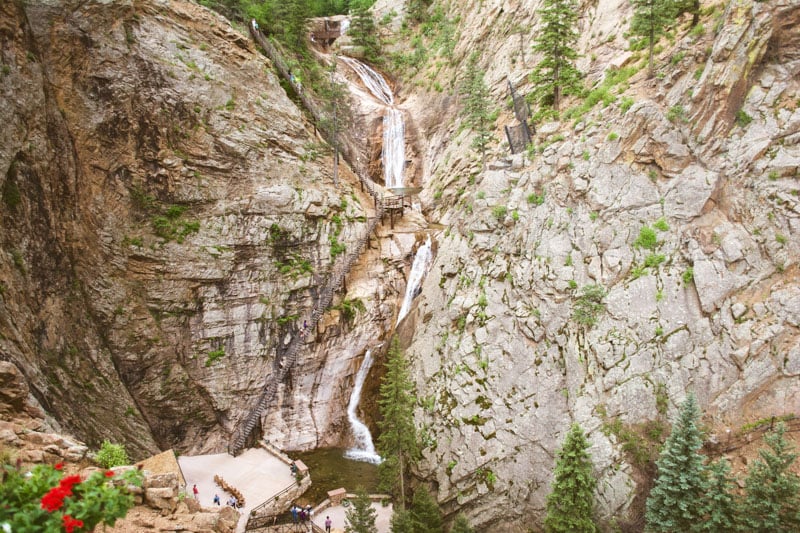
In the winter, Pikes Peak Highway often has snow at the higher elevations, so check road conditions before you go. The drive can be a bit nerve-wracking if you’re not used to mountain roads, especially in icy conditions.
Days 10-11: Great Sand Dunes National Park
After a 2.5-hour drive from Colorado Springs, you’ll find yourself surrounded by towering sand dunes, some of which reach over 700 feet high, making them the tallest in North America. The contrast between the dunes and the backdrop of the Sangre de Cristo Mountains is something you’ve got to see to believe.
Plus, because the park is a bit off the beaten path, it’s often less crowded than some of Colorado’s other national parks, giving you a more peaceful, immersive experience. The best time to visit is late spring through early fall, when Medano Creek is flowing, and the weather is perfect for exploring.
Here are my recommendations:
- Star Dune: If you’re up for a challenge, hiking to the top of Star Dune is a must. It’s the tallest dune in North America, standing at over 750 feet. The hike is about 5 miles round trip and takes around 5 hours, but the views from the top are absolutely worth it.
- Medano Creek: This seasonal creek flows at the base of the dunes and is a favorite spot for families to cool off. The creek usually starts flowing in late May and can last through July, depending on the snowmelt. It’s shallow and perfect for splashing around or even building a sandcastle.
- Sandboarding and Sand Sledding: Yes, you can actually sandboard and sled down the dunes! You can rent sandboards and sleds in nearby towns like Alamosa or at the Oasis Store just outside the park. It’s super fun but definitely takes a little practice. My tip is to lean back and keep your weight centered to avoid nose-diving into the sand.
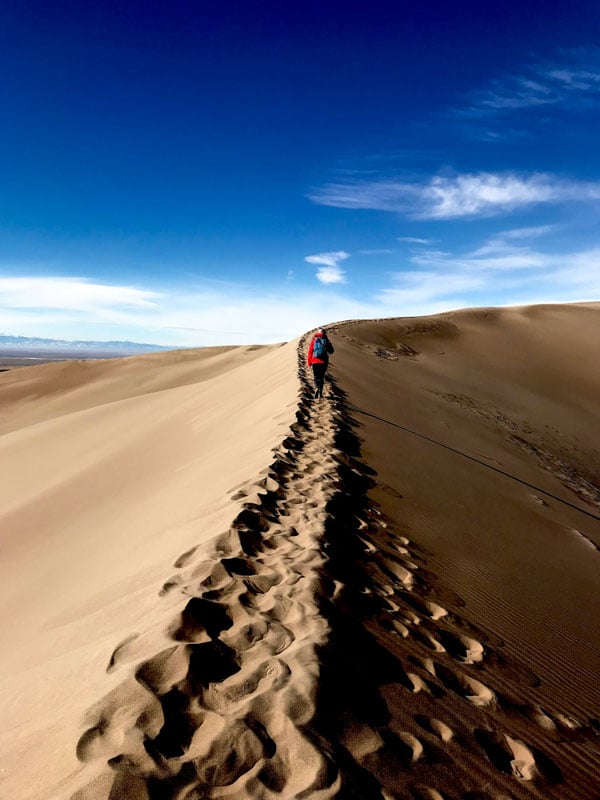
More Sights to See
- High Dune on First Ridge: If you’re looking for a shorter hike than Star Dune but still want incredible views, High Dune on First Ridge is a great option. It’s about 2.5 miles round trip and takes you to the top of one of the highest dunes near the parking lot. From the top, you’ll get sweeping views of the entire dune field and the surrounding mountains.
- Zapata Falls: Just a short drive from the park, Zapata Falls is a hidden gem that’s well worth the side trip. The hike to the falls is only about half a mile, but it can be a bit tricky, especially in spring when the creek is flowing strong. You’ll have to wade through the creek to reach the falls, so wear shoes you don’t mind getting wet.
- Mosca Pass Trail: If you’re in the mood for a forested hike, the Mosca Pass Trail is a beautiful option. This 7-mile round trip trail takes you through a lush canyon with plenty of shade and a more gradual incline. It’s a nice break from the sand and offers a different perspective on the park’s diverse landscapes.
- Camping at Piñon Flats Campground: If you want to fully immerse yourself in the beauty of the dunes, consider camping at Piñon Flats Campground. The sites are spacious, and many offer incredible views of the dunes and mountains.
Accommodation Options
Here are a couple of solid options for accommodations near Great Sand Dunes National Park:
- Great Sand Dunes Lodge: Located just outside the park entrance, this lodge offers comfortable rooms with amazing views of the dunes and the Sangre de Cristo Mountains. It’s the closest option if you want to be right near the action.
- Piñon Flats Campground: For those looking to camp, this campground inside the park offers a fantastic experience. You’ll be surrounded by nature with easy access to the dunes and excellent stargazing opportunities at night.
- Alamosa: If you prefer staying in a town with more amenities, Alamosa is about 30 minutes away and offers a variety of hotels, including Fairfield Inn & Suites and Hampton Inn. It’s a good base if you want more dining options.
Days 12-13: Durango
Durango is a charming, historic town in southwest Colorado, and after a scenic 3-hour drive from Great Sand Dunes National Park, you’ll find yourself in a place that feels like it’s straight out of an Old West movie. Durango is famous for its well-preserved downtown, packed with shops, restaurants, and historic hotels, but it’s also an adventure hub.
If you’re visiting in the summer, the Animas River is perfect for rafting or tubing, and the train ride to Silverton offers some of the best mountain views you’ll find anywhere.
Here’s how to spend your two days here:
- Durango & Silverton Narrow Gauge Railroad: This iconic steam train ride is the highlight of any visit to Durango. The railroad has been in operation since 1882, originally built to transport silver and gold ore. Today, it’s a scenic tour that takes you from Durango to the old mining town of Silverton, winding through the San Juan Mountains, one of the top mountains in Colorado. The trip takes about 3.5 hours each way. You can choose from a variety of car classes, from open-air gondolas to luxury cars.
- Historic Downtown Durango: Stroll along Main Avenue, where you’ll find everything from art galleries and boutiques to cozy cafes and breweries. Stop by the Strater Hotel, one of Durango’s most famous landmarks, for a drink at the Diamond Belle Saloon.
- Animas River Trail: This paved trail runs for 7 miles along the Animas River. It’s perfect for a leisurely walk or bike ride. The trail takes you through some scenic parts of town, and you’ll often see locals fishing, kayaking, or just hanging out by the river..
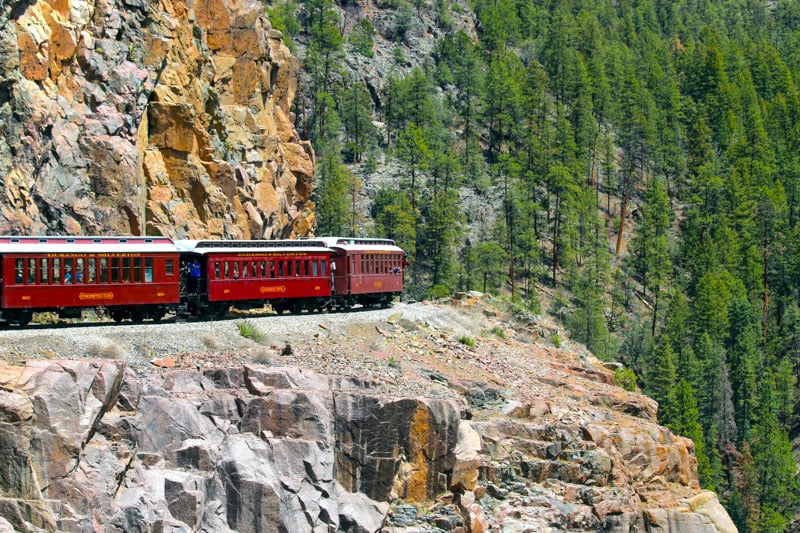
More Things to Do in Durango
- San Juan National Forest: Surrounding Durango, this vast forest offers endless opportunities for outdoor adventures. You can hike, bike, or drive through the scenic mountain passes. If you’re up for a challenge, the Hermosa Creek Trail is a local favorite, offering stunning views and a true backcountry experience.
- Purgatory Resort: If you’re visiting in the winter, Purgatory Resort is the place to be for skiing and snowboarding. It’s about 30 minutes north of Durango and offers a mix of runs for all levels, plus some breathtaking mountain views. In the summer, the resort transforms into an adventure park. Expect activities like mountain biking, an alpine slide, and scenic chairlift rides.
- Durango Hot Springs Resort & Spa: The Durango Hot Springs Resort offers a variety of pools with different temperatures, plus spa services if you’re in the mood for some extra pampering. It’s a great way to unwind and enjoy the beautiful mountain surroundings.
Day Trip Idea: Although technically not in Durango, Mesa Verde National Park is only a 45-minute drive away, and it’s a must-visit if you’re in the area. The park is famous for its well-preserved cliff dwellings, built by the Ancestral Puebloans over 700 years ago.
You can take a guided tour of sites like Cliff Palace and Balcony House, where you’ll learn about the history and culture of the people who once lived here.
Days 14-15: Mesa Verde National Park
This park is a UNESCO World Heritage site, and it’s absolutely fascinating to explore. The cliff dwellings are tucked into the sides of steep canyons, and you can’t help but wonder how people managed to live and thrive in such a rugged landscape.
After an easy 1-hour drive from Durango, you’ll find yourself in a world of ancient cliff dwellings, built over 700 years ago by the Ancestral Puebloans. The park is a mix of easy scenic drives, short hikes, and guided tours, so there’s something for everyone
Here’s what to see:
- Cliff Palace: This is the largest and most famous cliff dwelling in Mesa Verde. The guided tour takes you right into the heart of the dwelling, where you’ll climb ladders and walk through narrow passages to see the various rooms and kivas (ceremonial chambers).
- Balcony House: If you’re up for a bit of adventure, the Balcony House tour is for you. This tour is a bit more strenuous, involving climbing a 32-foot ladder. You’ll also be crawling through a short tunnel, and navigating along cliff edges. The payoff is worth it—you’ll get to explore a well-preserved dwelling with some incredible views of the canyon below. Just be prepared for a bit of a workout!
- Spruce Tree House: Spruce Tree House is the third-largest cliff dwelling in the park and one of the best-preserved. It’s usually a self-guided site, allowing you to explore at your own pace. It’s an easy walk from the Chapin Mesa Archeological Museum!
- Mesa Top Loop Road: This 6-mile scenic drive takes you to several overlooks and short trails that offer views of different cliff dwellings and archaeological sites. The interpretive signs along the way provide plenty of context about the history and culture of the Ancestral Puebloans.
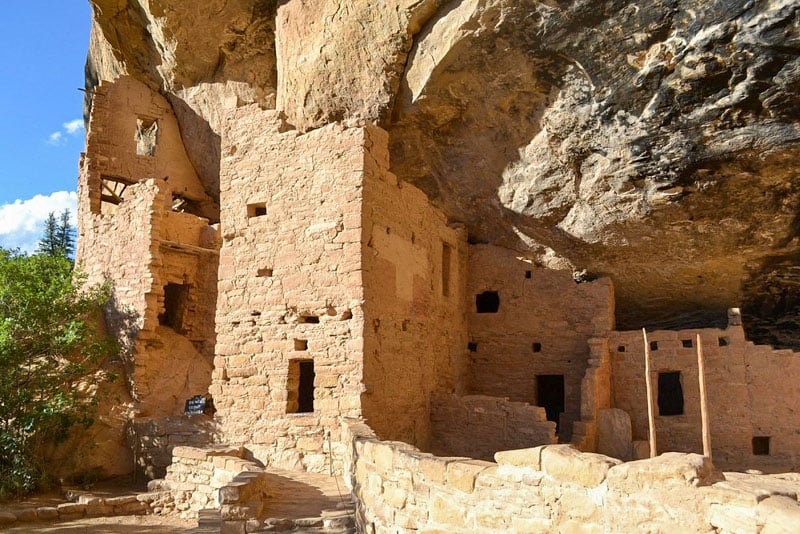
More Attractions
- Far View Sites Complex: This area is home to several ancient villages that once housed hundreds of people. As you wander through the ruins, it’s easy to imagine what life was like here over a thousand years ago. The walk is flat and easy, making it accessible to most visitors. It’s also a great spot to enjoy a picnic while taking in views of the surrounding mesas.
- Petroglyph Point Trail: If you’re up for a hike, the Petroglyph Point Trail is a 2.4-mile loop that offers fantastic views of Spruce Canyon. The highlight of the trail is a large panel of petroglyphs that give you a glimpse into the spiritual world of the Ancestral Puebloans.
- Chapin Mesa Archeological Museum: This museum is a must-stop before or after exploring the park. It’s filled with artifacts, dioramas, and exhibits that give you a deeper understanding of the Ancestral Puebloans who once lived in Mesa Verde. Plus, since it’s located right next to Spruce Tree House, it’s convenient to visit both in one trip.
Days 16-17: Telluride
One of the best things about Telluride is that you don’t have to go far to find amazing things to do. The town itself is super walkable, with a historic downtown area full of cool shops, cafes, and restaurants.
After a scenic 2.5-hour drive from Mesa Verde, you’ll roll into this charming town that’s surrounded by towering peaks and filled with history, character, and plenty of outdoor adventure.
Add these activities to your Colorado itinerary:
- Telluride Gondola: This free gondola ride is an absolute must-do when you’re in town. It connects Telluride with the Mountain Village, offering stunning panoramic views of the surrounding mountains and valleys. The ride is especially beautiful at sunset when the peaks are bathed in golden light. It’s also a great way to get up to the Mountain Village for some hiking or just to explore.
- Bridal Veil Falls: As Colorado’s tallest free-falling waterfall, Bridal Veil Falls is a spectacular sight. The falls are located at the end of a 1.8-mile trail (one way) that’s accessible from the town. It’s a bit of a climb, but the views at the top are totally worth it. In the winter, the falls freeze over, creating a popular spot for ice climbers. If you’re not up for the hike, you can also drive up to the base of the falls.
- Telluride Historic District: Take some time to explore the town’s historic district, which is full of well-preserved Victorian-era buildings. The Sheridan Opera House is a highlight—this historic venue still hosts performances and events, and it’s worth popping in to see what’s on.
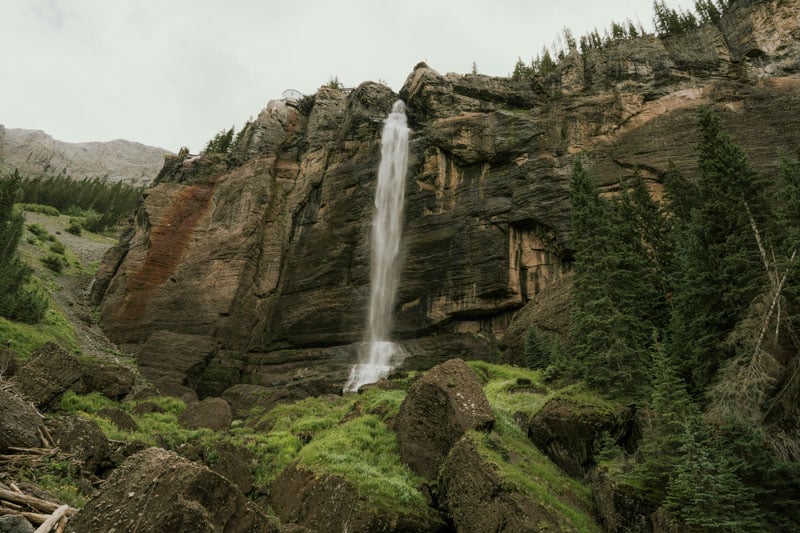
Additional Attractions
- Bear Creek Trail: If you’re looking for a beautiful hike that’s not too strenuous, the Bear Creek Trail is a local favorite. The trailhead is right in town, and it takes you up through a lush canyon to Bear Creek Falls. It’s about 5 miles round trip, with moderate elevation gain, and the views along the way are gorgeous.
- Mountain Village: If you take the gondola up, make sure to spend some time exploring Mountain Village. It’s got a more modern, resort-style feel compared to the historic town below, but it’s still super charming. There are some great restaurants and shops up here, plus you can access even more hiking and biking trails.
- Alta Lakes: Just a short drive from Telluride, Alta Lakes is a stunning area with several alpine lakes surrounded by rugged peaks. It’s a great spot for a day trip, whether you’re into fishing, kayaking, or just want to soak in the views. There are some rough roads getting up there, so a 4WD vehicle is recommended.
If your visit coincides with one of Telluride’s many festivals, you’re in for a treat. The town hosts everything from music festivals like Telluride Bluegrass to film festivals and even a Mushroom Festival!
Days 18-19: Aspen
Aspen, just a 4.5-hour drive from Telluride, is known for its world-class ski slopes, but there’s so much more to it than just winter sports. The town itself is charming, with a lively arts scene, fantastic restaurants, and some serious history, making it one of the top places to live and visit in Colorado.
If you’re visiting in the fall, the drive through the Maroon Bells Scenic Area is something you absolutely don’t want to miss—it’s like stepping into a postcard.
Explore Maroon Bells
These are probably the most photographed mountains in North America, and for good reason—they’re absolutely stunning. The twin peaks of Maroon Bells are reflected in Maroon Lake, creating a picture-perfect scene that’s even better in person.
The Maroon Lake Scenic Trail is an easy, flat walk that takes you around the lake with incredible views the whole way. If you’re up for more of a hike, the Crater Lake Trail is a great option, taking you deeper into the wilderness. In the fall, the entire area lights up with golden aspen trees, making it a must-see.
Nightlife in Aspen
Take some time to explore downtown Aspen, where you’ll find a mix of high-end boutiques, art galleries, and some seriously good restaurants. The pedestrian-friendly streets make it easy to wander and discover new spots.
I’d recommend stopping by Wheeler Opera House, a historic venue that still hosts live performances. You can also grab a drink at Justice Snow’s, a local favorite known for its creative cocktails.
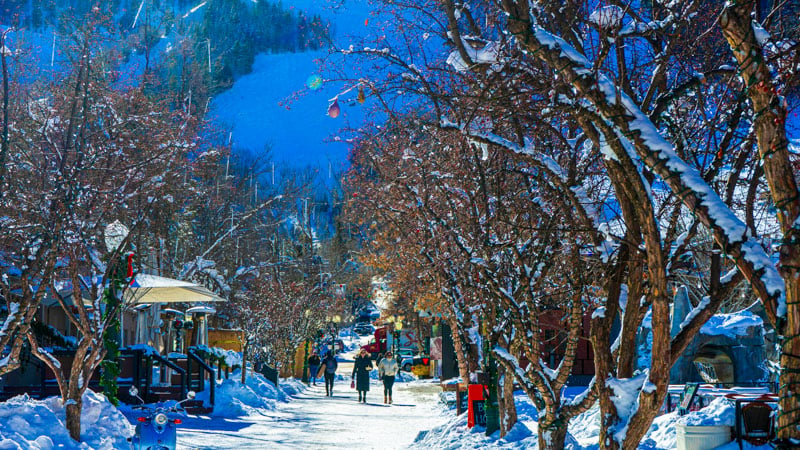
More Attractions in Aspen:
- Independence Pass: This road climbs over 12,000 feet, offering jaw-dropping mountain views. There are plenty of pull-offs to stop, take in the scenery, and snap some photos. The pass is only open from late May through October, so plan your visit during the warmer months.
- Aspen Mountain (Ajax): The Silver Queen Gondola runs year-round, taking you from downtown Aspen to the summit. At the top, you’ll find incredible views of the Elk Mountains. In summer, you can hike or mountain bike on the trails, and in winter, it’s all about skiing and snowboarding.
- John Denver Sanctuary: This peaceful spot along the Roaring Fork River is dedicated to the legendary musician John Denver. It’s a beautiful place in Colorado for a stroll, with large rocks engraved with his song lyrics and plenty of spots to sit and reflect.
- Aspen Art Museum: If contemporary art is your thing, the Aspen Art Museum is a must-visit. The building itself is a work of art, and inside, you’ll find rotating exhibits featuring top contemporary artists from around the world. Admission is free, making it easy to pop in for a quick visit.
- Aspen Highlands: In winter, Aspen Highlands is a skier’s paradise with some of the best expert terrain in the country. During summer, it’s great for hiking, and the views from the Highland Bowl are breathtaking, making it one of the best places to visit in the US. The hike up is tough, but worth it if you’re up for the challenge.
Days 20-21: Glenwood Springs
Nestled in the Roaring Fork Valley and surrounded by the Rockies, Glenwood Springs offers everything from scenic hikes to charming downtown strolls, making it a great final stop on your road trip.
Just an easy 1-hour drive from Aspen, this town is all about relaxation and enjoying the natural beauty of the area. Glenwood Springs is famous for its hot springs, but there’s a lot more to it than just soaking in warm water (although that’s definitely a highlight!).
Check out my favorite things to do in Glenwood Springs:
Enjoy the Hot Springs
The Glenwood Hot Springs Pool is the main attraction in town and the world’s largest hot springs pool. It’s a great place to soak your tired muscles after all those hikes, with a massive pool fed by natural hot springs.
The pool is open year-round, so you can enjoy a warm dip even in the middle of winter. There’s also a separate therapy pool that’s a bit hotter if you really want to relax. I recommend going in the evening when it’s a bit quieter and the mountain views are particularly stunning.
If you’re looking for a more intimate hot springs experience, Iron Mountain Hot Springs is the spot. It’s a collection of smaller, more private pools right along the Colorado River. Each pool has a different temperature, so you can find the one that’s just right for you. The riverside setting makes it feel like a hidden gem, and it’s the perfect place to unwind and enjoy the view.
More Attractions in Glenwood Springs
- Hanging Lake: This is one of Colorado’s most iconic hikes, and for good reason. The trail is a steep 1.2-mile climb (2.4 miles round trip) that leads to a breathtaking turquoise lake with waterfalls cascading into it. And heads up! You’ll need to get a permit in advance to do this hike, as it’s a very popular spot.
- Glenwood Caverns Adventure Park: This isn’t your typical amusement park! Glenwood Caverns is located on top of a mountain and offers a mix of cave tours, thrill rides, and stunning views. You can take a guided tour through the caves to see some incredible formations. Afterwards, you can hop on a roller coaster that literally hangs off the edge of the mountain. The gondola ride up to the park alone is worth the trip, with panoramic views of the entire valley.
- Glenwood Canyon: If you’re in the mood for a scenic drive, Glenwood Canyon is absolutely beautiful. The canyon is carved by the Colorado River, and the views are spectacular, especially in the fall when the leaves are changing. There are several pull-offs along I-70 where you can stop and take in the scenery. You can also hop on the Glenwood Canyon Recreation Trail, a paved path that runs along the river and is perfect for a peaceful walk or bike ride.
- Downtown Glenwood Springs: Here you’ll find a mix of local shops, cafes, and restaurants. Stop by Rifle Falls State Park for a short detour. It’s a little out of town but offers a cool triple waterfall that’s worth the trip. In town, Juicy Lucy’s Steakhouse is a great spot for dinner if you’re in the mood for a good steak.
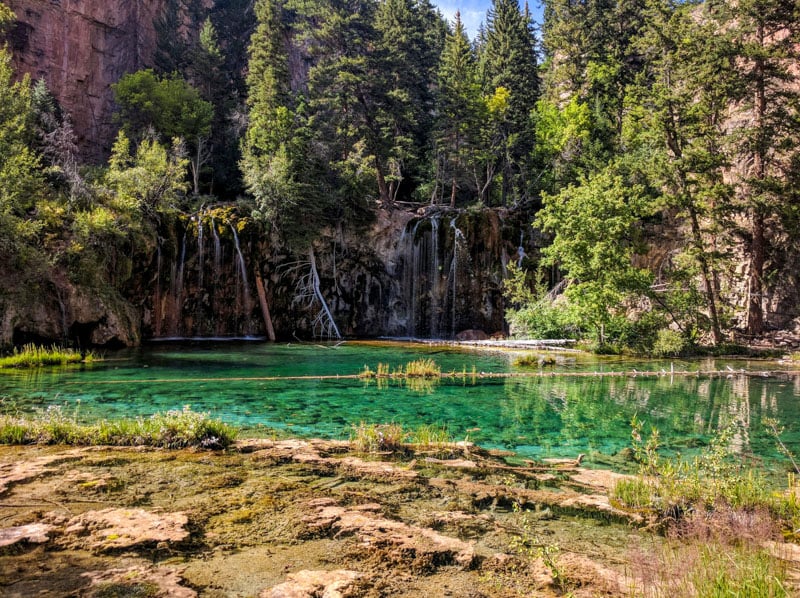
The Drive Back to Denver
The drive back is about 2.5 to 3 hours, depending on the route you take and how many scenic stops you decide to make along the way. Here’s a look at your options:
Route 1: I-70 East (The Most Direct Route)
The most straightforward way back to Denver is to hop on I-70 East. This route takes you straight through Glenwood Canyon again, so you’ll get to enjoy those incredible canyon views one more time.
After that, you’ll drive through some of Colorado’s most popular ski towns, like Vail and Breckenridge, before winding your way back into Denver. If you’re looking to get back quickly, this is your best bet.
Route 2: Independence Pass and US-285 (A Scenic Detour)
If you want to squeeze in a bit more adventure, consider taking Independence Pass back toward Denver. This route is only available in the warmer months (usually late May through October) and is one of the most scenic drives in Colorado.
You’ll pass through the stunning Independence Pass and then connect with US-24. Eventually, you’ll merge onto US-285, which will take you back to Denver. It’s a bit longer than the I-70 route, but the views are well worth it.
Things to Keep in Mind When Planning Your Road Trip
Before you pack up and start your Colorado adventure, here are a few important things to consider to make your trip smooth and enjoyable.
Where to Start Your Road Trip
Starting your Colorado road trip is all about choosing the right spot. Denver is the go-to for most people—it’s the state capital, has a major airport, and offers easy access to the Rockies. If you’re closer to the south, Colorado Springs is a great alternative.
This is especially true if you’re interested in the southern attractions like the Great Sand Dunes. For those coming from the west, Grand Junction is perfect, giving you quick access to Colorado’s wine country and the stunning Colorado National Monument.
No matter where you start, Denver, Colorado Springs, or Grand Junction are solid options to kick off your adventure.
Best Time of Year for a Colorado Road Trip
Choosing the best time for your road trip depends on what you want to experience:
- Spring (April to June): Great for wildflowers and avoiding summer crowds, but expect unpredictable weather—pack layers!
- Summer (July to September): Peak season with warm weather, open trails, and festivals. Perfect for outdoor activities but expect more crowds.
- Fall (September to October): Cooler temperatures, stunning fall foliage, and fewer crowds make this the best time to visit. My favorite!
- Winter (November to March): Ideal for skiing and winter sports, but be prepared for cold and potential road closures.
If I had to pick one season, fall wins for its combination of beauty, weather, and tranquility.
Number of Days for a Colorado Road Trip
How long to spend on your road trip? Here’s a quick guide:
- Weekend Getaway (3-4 days): Focus on one or two areas like Denver and Rocky Mountain National Park or Colorado Springs and Great Sand Dunes for a quick taste of Colorado.
- One Week (7-10 days): Hit the highlights without rushing. A good route might include Denver, Boulder, Rocky Mountain National Park, and a few mountain towns.
- Two Weeks (14-16 days): Explore more remote areas like Mesa Verde, take your time in spots like Telluride, and enjoy a balanced mix of city, mountain, and cultural experiences.
- Three Weeks (21 days): The full Colorado experience. See everything from the eastern plains to the western slope at a relaxed pace, with time for off-the-beaten-path adventures.
For a well-rounded trip, a week to 10 days is ideal. But if you can spare two to three weeks, you’ll get the full Colorado experience without feeling rushed.
Other Destinations to Consider for Your Road Trip
If you’ve got a little extra time and want to explore more of what Colorado has to offer, here are a few fantastic spots to add to your itinerary:
- Black Canyon of the Gunnison: Known for its dramatic, steep cliffs and the Gunnison River cutting through it, this lesser-known national park offers some incredible views and hiking opportunities. It’s quieter than the Grand Canyon but just as awe-inspiring.
- Crested Butte: Often called Colorado’s wildflower capital, Crested Butte is a great spot for hiking and mountain biking in the summer, with vibrant meadows in full bloom. It’s a top-notch Colorado winter destination for skiing without the big crowds.
- Pagosa Springs: Located near the San Juan Mountains, Pagosa Springs is famous for its hot springs and outdoor adventures. Whether you’re into soaking in the springs or hiking in the nearby wilderness, this town is a perfect retreat.
- Steamboat Springs: A little off the beaten path, Steamboat offers a genuine mountain town vibe with fantastic skiing in the winter. In the summer, it offers beautiful hiking trails. Don’t miss the natural hot springs here, either.
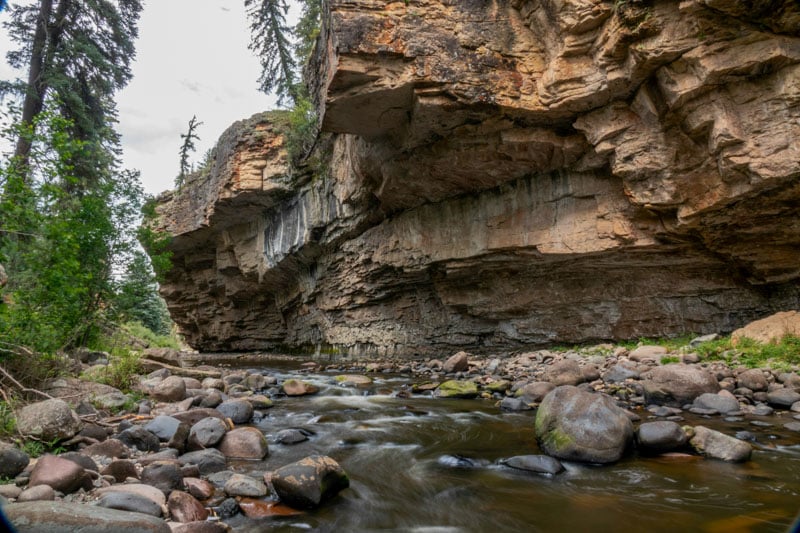
FAQs About the Colorado Road Trip
Planning your Colorado road trip is super exciting, but you might have some questions. Here are answers to common queries to help you plan your adventure exploring Colorado.
What does a 5-day road trip in Colorado look like?
If you’re short on time but want to hit the highlights, here’s a condensed 5-day itinerary:
- Day 1: Denver: Explore the city’s top attractions like Union Station, the Denver Art Museum, and Red Rocks Park. Enjoy dinner at one of the trendy downtown spots.
- Day 2: Boulder: Hike in Chautauqua Park, stroll Pearl Street, and visit the Celestial Seasonings Tea Factory.
- Day 3: Rocky Mountain National Park: Drive Trail Ridge Road, hike around Bear Lake, and enjoy wildlife spotting.
- Day 4: Colorado Springs: Visit Garden of the Gods, take the Pikes Peak Cog Railway, and explore Manitou Springs.
- Day 5: Great Sand Dunes National Park: Hike the dunes, splash in Medano Creek (seasonal), and take in the unique landscapes.
How long does it take to drive around Colorado?
The total driving time depends on your route, but you can expect around 20-25 hours of driving spread out over your trip while staying in Colorado. For example, Denver to Rocky Mountain National Park is about 1.5 hours, Colorado Springs to Great Sand Dunes is around 2.5 hours, and Great Sand Dunes to Durango is approximately 3 hours.
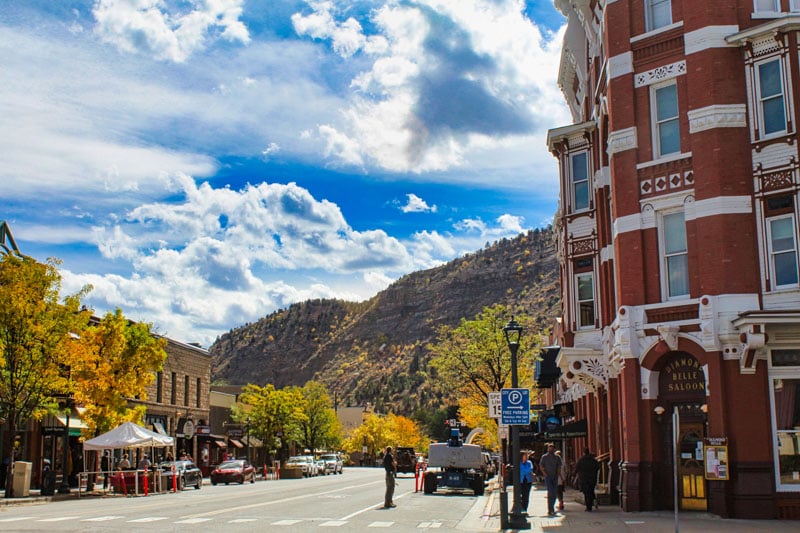
Can you take a Colorado road trip in 7 days?
Absolutely! Here’s a sample 7-day itinerary:
- Day 1: Denver: Explore the city’s highlights.
- Day 2: Boulder: Dive into the outdoor scene and local culture.
- Day 3: Rocky Mountain National Park: Experience the park’s stunning beauty.
- Day 4: Colorado Springs: Discover the city’s natural wonders.
- Day 5: Great Sand Dunes National Park: Marvel at the dunes and enjoy unique outdoor activities.
- Day 6: Durango: Ride the Durango & Silverton Narrow Gauge Railroad and explore the historic town.
- Day 7: Mesa Verde National Park: Visit the ancient cliff dwellings before heading back to Denver.
What kind of car is best for this trip?
A comfortable, fuel-efficient car is perfect for this trip. A midsize car will handle most of the roads just fine, but if you plan to explore off-the-beaten-path areas or visit in winter, a small SUV with all-wheel drive might be a better choice.
Are there any tolls on the way?
Yes, there are a few toll roads in Colorado, mainly around the Denver metro area. The E-470 toll road is commonly used to bypass traffic or reach Denver International Airport. You’ll want to check if your rental car includes a toll payment option or pay online afterward.
Is it possible to explore this route without a car?
While you can visit major cities like Denver and Colorado Springs using public transportation, having a car is the best way to fully experience Colorado’s diverse landscapes and reach more remote areas. If driving isn’t an option, consider joining guided tours for specific areas, but keep in mind that a car offers the most flexibility and convenience.
